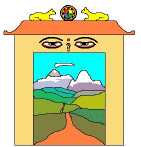
|
The Namche Conference: May 24-26,
2003
Sessions Report |
Session 4: e-Consultations follow-up. 4b – Security Facilitator: Dr. Seth Sicroff, Bridges-PRTD Points raised during the e-discussion: 1) Role of government/army/police. Should the government restrict areas? 2) Do tourists pose any dangers to host community? 3) Are locals offended by tourist behavior? 4) Are the following proposals valid? - Rolwaling institute - Setting standards for Everest - Mountain rescue squads 5) Establishing communication network in Khumbu 6) Porter protection Discussion 1) Role of government/army/police. Should the government restrict areas? The army is not necessary for tourism safety. It is not appropriate for a national park. The location of its post in SNP is not good if the goal is to protect Namche from the Maoists. If the objective is to try to avoid a Chinese invasion, the post is not big enough. Porter bags and other suspicious loads should be checked down below (i.e. at Jorsaale). This was briefly implemented in 2002 but, for some reason, they don’t do it any more. The army has cut trees under the idea that they would be able to see the Maoists coming. They don’t care about the environment; they are allowed to cut firewood. About governments (esp. the US government) issuing travel advisories: - No foreigners have been killed by the Maoists - Security warning to protect citizens has extreme impact on tourism (uneven effects) - The biggest risk is bandits. Could a communication line to army/police to report bandits in order to avoid exaggerated reports Should each government be responsible for rescuing its citizens? Who should pay if someone gets hurt and needs rescuing? - It is one’s responsibility - Your own insurance should pay - Government could pay for your rescue and worry about being reimbursed later - In case of a sick tourist who represents a thread, the German government will conduct a thorough rescue What happens if the government knows there is an imminent risk and covers it up, and an accident occurs? (Guide service would have to pay a lot of money) - Tourists government should find a way to get money from the host government - Newspapers may even choose self-censorship - Tourists shouldn’t be surprised and shouldn’t have fair expectations 4) Utility of the RMLI. - Biggest GLOF threat - Let researchers be responsible for announcing the threat - INGOs pretend projects are OK but researchers can challenge these arguments Rules for Everest - 95% of Everest climbers are not mountaineers; they shouldn’t be allowed to climb - when setting up teams, guides should check climbing resume - since cost is so high, money matters most; can/do pay Sherpas to carry down when have trouble - NMA getting rich on climbing permits ($10,000/person) so has no reason/motivation to keep people from climbing - bring Alpine Associations to Kathmandu to set up a standard rating system with rules stating as a must to climb lower and easier mountains before being able to climb Everest - will force people to climb other mountains - If police should be responsible for rescuing lost trekkers, then they must be trained for it - a doctor and a guard should be stationed at local clinics - there isn’t the proper equipment available if there was a need to set up a rescue – a rescue post should have these things available - is it too much of a luxury to expect help if you fall off a trail during an independent trek? - based on past experience with organized groups, very few problems with insurance payments have occurred - should the park force tourists to have rescue insurance? 5) Communication - may get rid of the $5000 fee to register a phone inside the park (in 2004) - when had local phone service, and within a year or so should have phone service repaired 2) Local perception of threats - No feeling of threat from tourists 6) Porters - should be a porter association to set standards for safety and protection; costs and quality - organizations already in place
|
Email: info@namche.net